1231-A
The General Radio 1231-B Amplifier and Null Detector was introduced in Catalog L (1948) and remained available through Catalog P (1959).
The Type 1231-B is a combination three stage hi-gain amplifier and dual range null detector. The first stage of the amplifier uses a two step attenuator, the second stage introduces variable gain control, finally the third stage applies tuning filters and amplification. The null detector or voltmeter has two ranges using push-buttons or can be disabled. The panel meter has two scales, voltage and decibels along with a battery check function. The 1231-B is designed for battery operation or AC operation using the Type 1261-A power supply. Regardless of power supply used the amplifier bias supply is provided by "Bias Cells".
A front panel phone jack is available for filters to apply to the amplifier. Accessory filters 1231-P2 60 Hz, 1231-P3 400 and 1000 Hz are available to tune the amplifier to those frequencies. The Type 1231-P5 variable filter covers 50 Hz to 100 kHz. To adapt the 1231-B for use with a slotted line the Type 1231-P4 adjustable attenuator is used for standing-wave ratio measurements. Caution: When using the 1261-A power supply the 1231-A must be switched on and an external switch controlling the power supply.
Specifications
- Input Impedance: 1 MΩ in parallel with 20 pF; alternate 10 MΩ input available
- Maximum Gain: Greater than 83 dB at 1 kHz with 1 MΩ load
- Null Detector Sensitivity: Less than 25 μV input gives 1% indication on meter at 1 kHz
- Output Impedance: Approximately 50 kΩ
- Maximum Output Voltage: 5 volts into 20 kΩ; 20 V into 1 MΩ



















